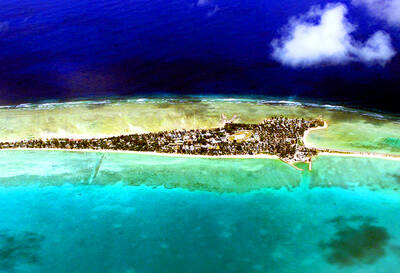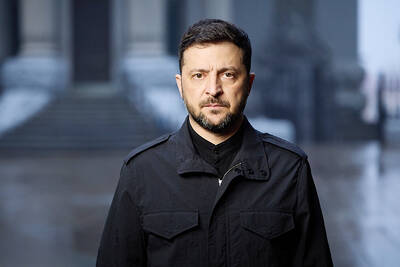Hundreds of delegates to a UN conference on disasters put the final touches on a pact yesterday that was to reflect strong support for the world body to create a tsunami alert system and help poor nations gird against cyclones, floods and other natural calamities.
But disputes over the wording of the document have underscored differences over just what causes such disasters.

PHOTO: AFP
The five-day meeting that wraps up today in Kobe had been reorganized to focus on finding money and sketching out details for a tsunami warning system for southern Asia, following the Dec. 26 earthquake and killer waves that hammered the Asian and African coastlines. Figures for the number of dead vary widely, from 157,780 to 221,110.
On Thursday, officials from the richest nations pledged roughly US$8 million to begin work on a new tsunami alert network in the Indian Ocean, expected to cost US$30 million and be operational by the middle of next year. A tsunami network in the Pacific, set up in 1965, now protects some 26 nations.
Scientists and officials have agreed on the merits of an Indian Ocean system, which could have allowed coastal residents to flee to safety had it been in place last month. Many support setting up a network that also monitors the Mediterranean, Caribbean and other parts of the globe.
However, they have disagreed about other issues on the conference agenda.
The 25-nation EU has backed poor island nations threatened by storms and rising ocean waters in pushing for a UN action plan -- expected to be adopted at the Kobe conference -- that would refer to climate change as a possible cause of future natural disasters.
But the US delegation, along with officials from Australia and Canada, has demanded that those references be deleted. Negotiations late on Thursday lasted into the early morning hours of yesterday.
"Climate change has become a very political issue," said Maryam Golnaraghi, who heads disaster-prevention at the Geneva-based World Meteorological Organization.
A UN-organized group of scientists, the Intergovernmental Panel on Climate Change, said in a recent assessment of climate science that rising global temperatures could lead to more extreme weather patterns that trigger cyclones and droughts.
Scientists attribute the trend to higher levels of carbon dioxide and other so-called greenhouse gases that occur naturally but have been boosted by factories and cars that burn fossil fuels.
The Kyoto Protocol, which takes effect Feb. 16, aims to limit emissions of those gases, which can trap heat in the atmosphere. US President George W. Bush has rejected the Kyoto Protocol, however, citing economic concerns.
Salvano Briceno, who heads the UN action plan for preventing disasters, played down the battle over the "framework for action." The draft document had cited climate change as a factor in natural disasters and called for officials to identify "climate-related disaster risks."
"It is not the intention of the US or any of the other nations to delete reference to climate change. The issue was whether it [climate change] should be referred to so many times," Briceno, director of the UN International Strategy for Disaster Reduction, told reporters on Thursday.

DISASTER: The Bangladesh Meteorological Department recorded a magnitude 5.7 and tremors reached as far as Kolkata, India, more than 300km away from the epicenter A powerful earthquake struck Bangladesh yesterday outside the crowded capital, Dhaka, killing at least five people and injuring about a hundred, the government said. The magnitude 5.5 quake struck at 10:38am near Narsingdi, Bangladesh, about 33km from Dhaka, the US Geological Survey (USGS) said. The earthquake sparked fear and chaos with many in the Muslim-majority nation of 170 million people at home on their day off. AFP reporters in Dhaka said they saw people weeping in the streets while others appeared shocked. Bangladesh Interim Leader Muhammad Yunus expressed his “deep shock and sorrow over the news of casualties in various districts.” At least five people,

It is one of the world’s most famous unsolved codes whose answer could sell for a fortune — but two US friends say they have already found the secret hidden by Kryptos. The S-shaped copper sculpture has baffled cryptography enthusiasts since its 1990 installation on the grounds of the CIA headquarters in Virginia, with three of its four messages deciphered so far. Yet K4, the final passage, has kept codebreakers scratching their heads. Sculptor Jim Sanborn, 80, has been so overwhelmed by guesses that he started charging US$50 for each response. Sanborn in August announced he would auction the 97-character solution to K4

SHOW OF FORCE: The US has held nine multilateral drills near Guam in the past four months, which Australia said was important to deter coercion in the region Five Chinese research vessels, including ships used for space and missile tracking and underwater mapping, were active in the northwest Pacific last month, as the US stepped up military exercises, data compiled by a Guam-based group shows. Rapid militarization in the northern Pacific gets insufficient attention, the Pacific Center for Island Security said, adding that it makes island populations a potential target in any great-power conflict. “If you look at the number of US and bilateral and multilateral exercises, there is a lot of activity,” Leland Bettis, the director of the group that seeks to flag regional security risks, said in an

‘DIGNITY’: The Ukrainian president said that ‘we did not not betray Ukraine then, we will not do so now,’ amid US pressure to give significant concessions to Russia Ukrainian President Volodymyr Zelenskiy on Friday pushed back against a US plan to end the war in Ukraine, while Russian President Vladimir Putin welcomed the proposal that includes many of his hardline demands. With US President Donald Trump giving Ukraine less than a week to sign, Zelenskiy pledged to work to ensure any deal would not “betray” Ukraine’s interests, while acknowledging he risked losing Washington as an ally. Putin said the blueprint could “lay the foundation” for a final peace settlement, but threatened more land seizures if Ukraine walked away from negotiations. Ukraine faces one of the most challenging moments in its history,